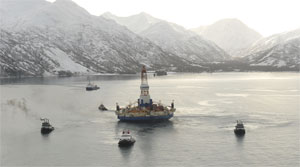After overcoming regulatory hurdles and environmental protests to resume offshore oil drilling in the Arctic, Royal Dutch Shell abruptly reversed course in September and suspended its efforts “for the foreseeable future” when an exploratory well produced disappointing results.
Shell announced on Sept. 28 that it found indications of oil and gas at the Burger J well in Alaska’s Chukchi Sea, but said the quantities were “not sufficient to warrant further exploration.” The company had received federal approval to bore two wells in the Burger prospect during the 2015 drilling season, which ran from July 15 to Sept. 28.
“The Shell Alaska team has operated safely and exceptionally well in every aspect of this year’s exploration program,” Marvin Odum, director of Shell Upstream Americas, said in a news release. “Shell continues to see important exploration potential in the basin, and the area is likely to be of strategic importance to Alaska and the U.S. However, this is a clearly disappointing exploration outcome for this part of the basin.”
The Burger J well is located about 150 miles west of Barrow, Alaska, in 150 feet of water. It was drilled to a depth of 6,800 feet. Shell said it would seal and abandon the well in accordance with U.S. regulations.
Shell’s return to the Arctic came two and a half years after the grounding of one of its drillships, Kulluk, off Sitkalidak Island, Alaska. The company’s 2012 campaign also was marred by problems involving the drillship Noble Discoverer, which was cited for safety and pollution violations after it lost propulsion and had to be towed to the port of Seward.
This year, Shell was faced with protests by hundreds of “kayaktivists” in Seattle and damage to the 380-foot icebreaker Fennica, part of the company’s 28-vessel Arctic flotilla.
Fennica, tasked with deploying a capping stack in the event of a well blowout or other emergency, sustained a gash in its hull after hitting an underwater obstruction while en route to the Chukchi Sea in July. The ship had to return to Vigor Industrial in Portland, Ore., for repairs.
In announcing its Arctic pullout in September, Shell cited the “high costs associated with the project, and the challenging and unpredictable federal regulatory environment in offshore Alaska.” Operational guidelines approved in May by the U.S. Bureau of Ocean Energy Management required Shell to have two drilling units in the area instead of one, more support vessels and oil response equipment, and more frequent visits by support vessels to the drillships.
“Normally in an exploration program, you like to drill several wells before you call it quits in a new basin and a new prospect,” said Lysle Brinker, director of equity research at IHS Energy. “But they had to have so many ships and backup and redundant systems, which is extremely expensive. And the window to drill the wells is so short that they decided to call it quits.”
Brinker said the decision doesn’t mean Shell won’t return to the Arctic, where the company has invested $7 billion on planning and operations during the past eight years. He said the timetable would depend to a large extent on a rebound in global oil prices.
“The really high-cost areas, such as the high Arctic, are the first areas where oil companies are cutting back,” Brinker said. “We’re calling for oil to get back up to the $80 to $90 (a barrel) level by the end of this decade, but even at those prices most Arctic prospects are not really economical. At the same time, these companies do have to think ahead.”

